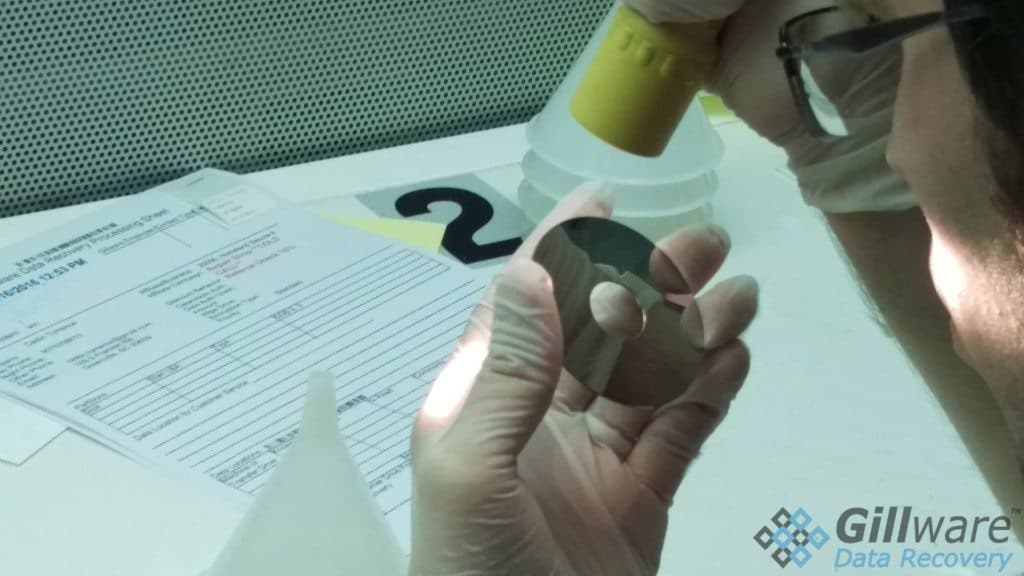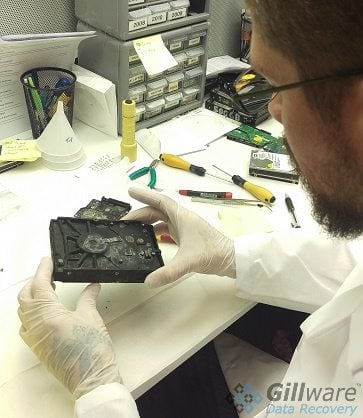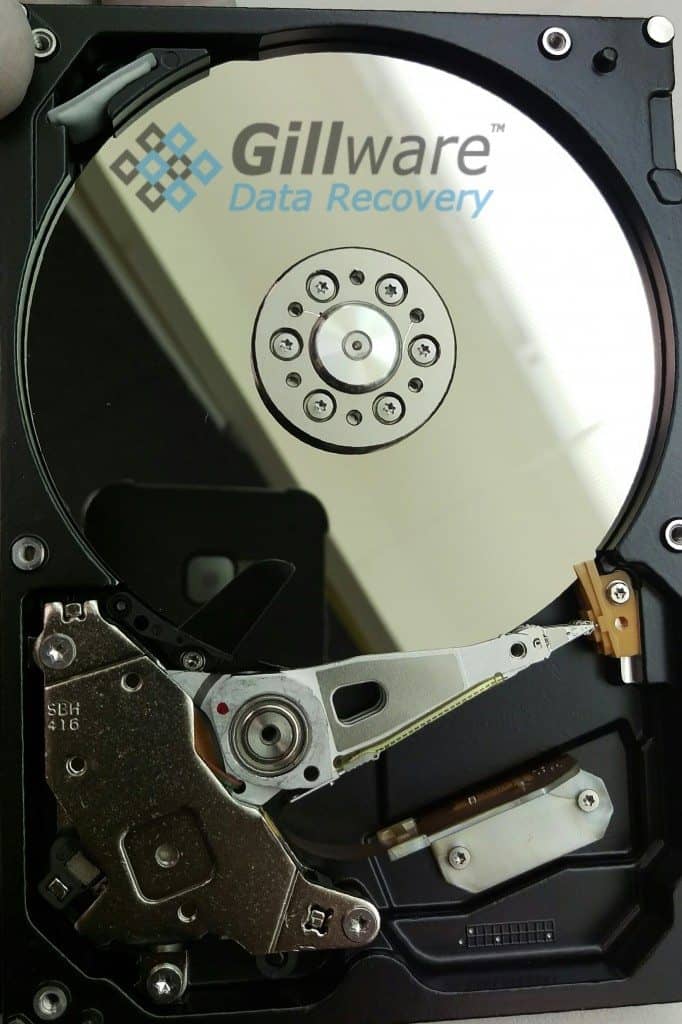Hard Drive Repair — Frequently-Asked Questions, Answered At Last
Whether it’s your family photos you need to have retrieved from a hard drive your cat knocked off the desk or a folder full of critical business documents stuck on a laptop that just won’t boot up anymore, Gillware’s hard drive repair experts are the best friends you’ll ever have.
When you want to know how to fix a hard disk error, or how to repair a corrupted hard disk, your first instinct might be to ask “how do I do it myself?” But when you want to recover data from a clicking hard drive, or you’re looking for hard drive repair tips for an external drive that doesn’t spin up, that instinct could put your data in even more danger.
Fortunately, that’s where we can help. If you need your data recovered from a broken hard drive, you can breathe a sigh of relief: You’ll find all the answers you seek here at Gillware.
Repairing failed hard disk drives requires highly specialized skills. For most people outside of the data recovery industry and hard drive manufacturers themselves, the inner workings of your hard drive are an enigma. As such, many of our clients have a lot of questions about hard drive repair, and our data recovery process in general. And there are no better people to ask these questions to than bona fide data recovery experts.
Hard drive repair isn’t like car repair
It’s not the kind of repair work you can choose to leave to a professional or find a more DIY solution. And not only can you not repair your hard drive the way you’d want your car repaired, you don’t actually want to. Hard drives are cheap and replaceable–your data is not. What you want is the data from your broken hard drive retrieved and recovered.
Need a Hard Drive Repaired?

Hard drive repair isn’t something just anyone can do. There are no DIY shortcuts to repairing a broken hard drive, no matter what random folks on the Internet might say about freezers and ovens and hammer tests. Only data recovery companies with professional cleanroom labs and skilled technicians can reliably perform the delicate work needed for hard drive repair.
Our data recovery lab offers:
- Free consultation
- Free in-lab evaluation
- Free inbound shipping
Still have questions about how hard drive repair works before you feel comfortable sending your hard drive to us? We’re happy to answer any questions you might have.
Hard Drive Repair FAQ, or “Everything You Wanted to Know About Hard Drive Repair But Were Too Afraid to Ask”
The seasoned engineers in our cleanroom have seen just about every model of hard drive invented over the past 20 years. (And a surprising amount of older hard drives as well.) When hard drive manufacturers like Seagate, Western Digital, and Hitachi unveil their new models, we know it’s only a matter of time before our engineers start seeing those in our lab, too. If you want to find people who know more about hard drives than us, you’ll be hard pressed to find any outside of the manufacturers themselves.
Allow us to demystify the world of hard disk drive repair and data recovery, the way only professionals can.
What Can I Do On My Own?
There are plenty of places that can tell you how to repair a hard disk error, how to fix an external hard drive, or how to repair a corrupted hard disk. These can help you a lot when you’re dealing with the kind of boot errors that are most likely to plague a healthy hard drive. Plenty of hard drive boot errors happen because of an issue as simple as a corrupted boot sector or important system files like the master boot record, and these issues are rarely caused by an actual breakdown of your hard drive’s components (although, of course, they can be).
But there are no easy (or helpful) DIY answers to “how to fix a clicking hard drive.”
1. How Can I Repair My Hard Drive?
The short answer to this question is: You can’t. Not on your own, at least. Hard drive repair should only be done by trained professionals in a clean environment.
A quick check on Google will show you plenty of DIY data recovery tutorials.
You’ll find sites showing you which screwdrivers you have to use to open up your hard drive.
You’ll find sites telling you how to unstick failed read/write heads from your drive’s platters or swap out the control board.
There will even be sites showing you how to remove the drive’s platters and stick them into another drive.
There are tons of video hard drive repair tutorials out there. Our professional advice is to not follow them and to leave this work to the kind of incredibly well-practiced folks you’ll find in a professional lab.
Hard disk repair is very difficult.
You can’t become an expert in hard disk repair from watching a video tutorial, much like how you can’t become a concert pianist just by watching one perform. Our hard drive recovery interns practice for months and are watched like hawks by senior engineers before we let them tackle customer drives on their own.
You might get lucky. You might be able to correct the problem on your own. And the drive might still work after you put it together (but it probably won’t). But before you open up your hard drive, ask yourself, “Do I feel lucky?”
Don’t let any local computer repair technicians open up your hard drive either.
Your local repair technician probably doesn’t have a cleanroom bench to work on. Open hard drives are extremely susceptible to contaminants in the air. Our cleanroom benches generate positive pressure to push clean, filtered air into and any dust particles out of our workstations. Hard drives should only be opened up in a cleanroom environment like our data recovery lab.

Isn’t there hard drive repair software I can use?
There are plenty of data recovery software tools, but most are not meant to be used on broken hard disk drives. The kind of hard drive repair software you have access to tends to only be useful if the hard drive has a non-physical error, for example, a corrupted boot sector. Software cannot repair a hard drive’s physical issue, especially if your hard drive is clicking, beeping, or not spinning.
Gillware uses advanced and specially-designed software tools, not to repair hard drives, but to assist our engineers in pulling important data off of freshly-repaired or moderately-damaged hard drives. You can find out more about how our in-house data recovery software works here.
Furthermore, hard drives aren’t meant to be fixed–not like your car, or a home appliance. When a hard drive breaks down, you’re meant to buy a new one. The data you’ve stored on it, however, is important, far more important than the drive itself, and that is what you need to have brought back to life–and that’s where we come in.
2. Do you ship my recovered data back on the same hard drive I sent in after you’ve repaired it?
This is a common question we hear from clients. As it happens, a repaired hard drive will not work like new.
Unlike your car, or your refrigerator, or your television, hard drives aren’t actually meant to be repaired. One exception is when hard drive manufacturers will take faulty hard drives (in many cases, drives that failed while under warranty and were sent back), wipe, repair, and recalibrate them, and sell them as recertified hard drives only if they pass stringent QA testing. Any repairs our engineers make are designed to be temporary, stopgap measures lasting us only long enough for us to salvage your data. Therefore, it’s better to put the salvaged data on a healthy drive and send it to you, rather than risk putting it on a hard drive that will likely fail again (and quite soon).
However, the technology needed to turn a broken drive into one that can function exactly like new simply isn’t available outside of Western Digital or Hitachi’s factory floor. If you are not a hard drive manufacturer, you are not meant to permanently repair hard drives.
Very precise calibrations have to be done to your hard drive when it rolls off of the assembly line. Every hard drive, even ones of the same model, even ones that came out of the factory next to each other, is slightly different. The control board and read/write heads inside your hard drive fit it like a bespoke suit. The one-in-a-million shot that we’ll find another suit off the rack that fits perfectly simply doesn’t happen. At best, we find replacement parts that are a near-perfect match.
A hard drive with nearly-perfect replacement parts inside it will usually function just well enough that our engineers can image and pull data off of it with our fault-tolerant data recovery tools. But in general, after we’ve had to repair a hard drive, it is no longer fit for duty inside or otherwise plugged into your computer.
Besides, we’d much rather put your data on a new password-protected external drive with hardware-level encryption. It’s a healthy drive, one we know will work. And it’s encrypted, so your data is totally secure on the off chance your data falls into the wrong hands on its way back to you. It’s a much better, and safer, way to return your data to you.
3. Where can I see the certification for your cleanroom benches?
While some data recovery labs prefer to go for overkill (and thus raise their operating costs unnecessarily), Gillware’s laminar airflow cleanroom workstations are designed to meet the same standards of cleanliness you would find in a hard drive manufacturer’s factory floor. An independent air filter specialist audits our cleanroom setup four times a year to make sure we meet ISO 5 Class-100 certifications for air cleanliness in our data recovery lab. The results of our cleanroom benches’ most recent compliance tests can be viewed here:
4. Can Gillware’s engineers recover data from damaged platters?
What Happens to Damaged Hard Disk Platters:
Your hard drive platters are made out of either aluminum or glass. A thin layer of ferromagnetic material coats their surfaces. The magnetic charges on this thin substrate actually determine which segments of it read as “1”s and which are “0”s. When a hard drive fails, the read/write heads can scrape off some of the substrate. The dust that used to be part of your data settles all over the platters. There’s no way to re-apply this dust to your platters, let alone put it back with the right magnetic charges. And the only way to access the data that’s still intact is to clean off the debris.
How We Fix It:
Up until a few years ago, no data recovery lab had the means to perform this kind of hard disk repair in a cost-effective manner. But Gillware has made breakthroughs in cleaning and polishing scratched platters. Severe platter damage can still make data recovery impossible. But through the use of our own hard drive platter burnishing technology, we can repair and salvage data from many hard drives with scratched platters.

We can only recover data from the undamaged portions of the platters, though, and if the damage occurs in the right place, even data from the undamaged portion might still be unrecoverable. If the portions of the platters containing the drive’s firmware have been damaged, for example, it is impossible for any form of contact to be made with the data on your hard drive.
Cases like these are partly why we offer free evaluations. Finding out that your data is unrecoverable is painful enough without being charged for the privilege of knowing. On top of that, if the damage is so severe that we can’t recover the data that’s important to you after all our hard work, we don’t charge you for any of our engineers’ efforts. Gillware’s mission is to make data recovery as painless as possible, even if it doesn’t work out.
5. I need my data back as soon as possible. What kind of expedited hard drive data recovery and repair options do you offer?
Our Priority emergency data recovery service reduces the average turnaround time of our engineers’ work dramatically for an additional fee added to the cost of data recovery. Depending on the circumstances, when you ask for Priority service, your device could spend as little as a single day in our lab before we have your data back. The cost of Priority service is typically two to three times the cost of standard data recovery.
Priority service puts your hard drive in the front of every line—for check-in, repairs, imaging, logical analysis, and extraction. Our hard drive recovery engineers work overtime, late into the night if need be, to get your data to you as quickly as possible. Emergency data recovery services are typically reserved for small businesses and organizations for whom minimizing downtime is a must to prevent a catastrophe; for 90% of our customers, standard service is sufficient.
Even after we’ve repaired a hard drive, the drive sets its own pace for its performance. Sometimes that pace happens to be less-than-ideal. We are often at the hard drive’s mercy. And unfortunately, your hard drive doesn’t care how much of a hurry you or our engineers are in. That said, when you need critical data back now, our engineers do whatever it takes to get your most important files off of your drive first and back in your hands as soon as possible.
6. Why isn’t the hard drive recovery cost per-gigabyte?
Charging per gigabyte for hard drive data recovery might seem reasonable for a data recovery lab at first glance. But it actually isn’t, and here’s why:
The hard work of hard drive data recovery comes from how much effort it takes to repair and access the drive, not how much data is on the drive. Imagine that two people send us a 1 TB desktop HDD, for example. Both drives require nearly-identical amounts of engineering time, effort, and replacement parts to get them up and running again. But one drive only has 15 gigabytes of documents, including the user’s Quickbooks file. The other drive belonged to a professional photographer and has 900 gigabytes of photos.
Recovering 15 gigabytes of documents does take less time than recovering 900 gigabytes of photos. But that is machine time—the time it takes for us to image a hard drive once it’s been repaired and extract its contents. The same amount of our hard drive recovery engineers’ time and effort had to go into repairing the hard drive for both cases.
Machine time is cheap. Engineer time is valuable. And we want to pay our engineers what their skills are worth (or else they’ll leave and find a job with a company that will pay them appropriately).
At Gillware, we’ve done a pretty good job at keeping the hard drive recovery cost affordable. Our prices are 40-50% lower than other professional hard drive recovery services. And our HDD data recovery service is truly financially risk-free: There are no evaluation fees, and we even offer to cover inbound shipping for you. You only pay us when we’ve recovered your data at an acceptable price to you.
7. Why Choose Gillware for Hard Drive Data Recovery?
Gillware’s data recovery services are affordably priced, technologically innovative and completely secure. Anyone looking for data recovery from a failed hard disk drive, from home users and small business owners to enterprise users, can rest easy when they send their drive to our lab for data recovery with a financially risk-free guarantee. We’re one of the best data recovery companies in the US, and for world-class expertise at a sensible and accessible cost, we simply can’t be beaten.
Gillware Does Hard Drive Repair Right
When your HP laptop starts giving you a Hard Disk 3F0 error or the Seagate hard drive in your PC starts beeping, you need to turn to the professionals. Our data recovery lab brings together some of the best hard drive repair experts in the world under one roof, and we make sure that if we can’t fix your hard drive and salvage the data that’s important to you at a cost that makes sense, you owe us nothing for our repair work.
There are many different types of hard drive failures, and Gillware excels at dealing with all of them. Other labs will sometimes outsource cases they can’t handle, but Gillware never outsources any of its cases. When you send your device to our lab, it stays at our lab.
